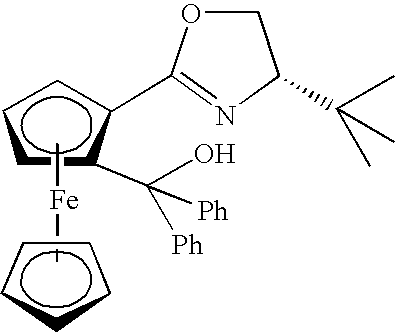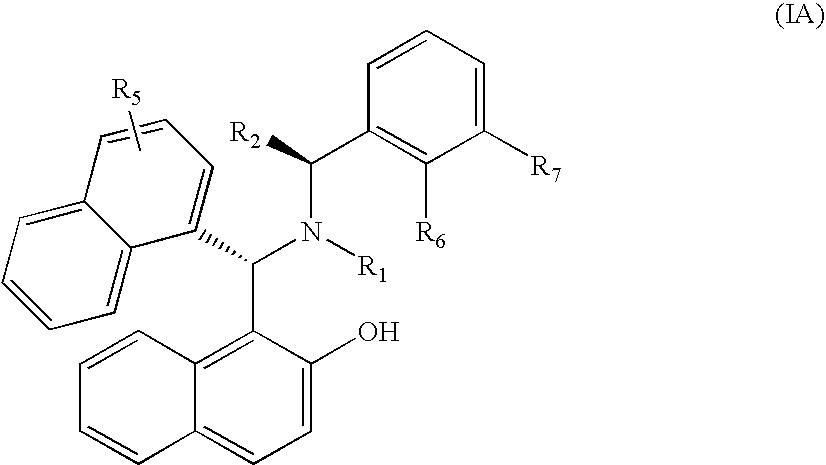Chiral Tertiary Aminoalkylnaphthols
a technology of aminoalkylnaphthol and tertiary aminoalkylnaphthol, which is applied in the field of chiral tertiary aminoalkylnaphthol, can solve the problems of low enantiomeric purity, difficult manufacturing, and low utility of corresponding aryl transfer reactions, and achieve high diastereomeric and enantiomeric purity
- Summary
- Abstract
- Description
- Claims
- Application Information
AI Technical Summary
Benefits of technology
Problems solved by technology
Method used
Image
Examples
example 1
1-{(S)-[Methyl-((S)-1-phenyl-ethyl)-amino]-naphthalen-1-yl-methyl}-naphthalen-2-ol
[0091]
[0092]1-Naphthaldehyde (2.7 mL, 20 mmol), (S)-(−)-N,α-dimetylbenzylamine (2.60 g, 19 mmol) and 2-naphthol (2.43 g, 16 mmol) are charged into a 25 mL flask with a magnetic stirring bar. The mixture is heated to 85° C. and stirred for 72 h. After the system is cooled to RT, MeOH (5 mL) is added and the precipitated product is collected by filtration, washed with MeOH (5 mL) and dried to afford 1-{(S)-[methyl-((S)-1-phenyl-ethyl)-amino]-naphthalen-1-yl-methyl}-naphthalen-2-ol as white crystals (about 51% yield): 1H NMR (500 MHz, CDCl3) δ 14.01 (brs, 1H), 7.77-7.02 (m, 18H), 6.45 (s, 1H), 4.40 (brs, 1H), 1.95 (s, 3H), 1.65 (brs, 3H); MS (EI) m / z (rel intensity) 418 (M++1), 283, 141, 136; HRMS (EI) Calcd for C30H28NO (M++1): 418.2171, found 418.2135.
example 2
(Method A)
(R)-(2-Chlorophenyl)phenylmethanol
[0093]
[0094]PhB(OH)2 (122 mg, 1.0 mmol) and ZnEt2 (334 μL, 3.25 mmol) in toluene (1 mL) is charged to a 10 mL flask under a nitrogin atmosphere. This mixture is heated to 60° C. and stirred for 10 h with a magnetic stirrer. Then the mixture is cooled to 0° C. and the title compound of Example 1, 1-{(S)-[methyl-((S)-1-phenyl-ethyl)-amino]-naphthalen-1-yl-methyl}-naphthalen-2-ol (16.7 mg, 0.04 mmol) in toluene (0.5 mL) and DiMPEG (100 mg, 0.05 mmol) in toluene (0.5 mL) are added. After stirring for additional 15 min, the solution is cooled to −15° C. and 2-chlorobenzaldehyde (70.0 mg, 0.5 mmol) in toluene (1 mL) is added. After stirring 15 h at −15° C., the reaction is quenched with 1 N hydrochloric acid (HCl, 2 mL) and the mixture is extracted with ethyl acetate (EtOAc, 5 mL), dried over anhydrous sodium sulfate (Na2SO4) and the solvent is removed in vacuo. The purification of the residue by flash chromatography (EtOAc / hexane, 1:10) gives (...
example 3
(Method B)
(R)-(2-Chlorophenyl)phenylmethanol
[0095]
[0096]PhB(OH)2 (122 mg, 1.0 mmol) and ZnEt2 (334 μL, 3.25 mmol) in toluene (1 mL) is charged to a 10 mL flask under a nitrogin atmosphere. This mixture is heated to 60° C. and stirred for 10 h with a magnetic stirrer. Then the mixture is cooled to 0° C. and 1-{(S)-[methyl-((S)-1-phenyl-ethyl)-amino]-phenyl-methyl}-naphthalen-2-ol (prepared as described by Chan et al., J. Org. Chemistry 2003, 68, 1589-1590; 14.7 mg, 0.04 mmol) in toluene (0.5 mL) and DiMPEG (100 mg, 0.05 mmol) in toluene (0.5 mL) is added. After stirring for additional 15 min, the solution is cooled to −15° C. and 2-chlorobenzaldehyde (70.0 mg, 0.5 mmol) in toluene (1 mL) is added. After stirring 15 h at −15° C., the reaction is quenched with 1 N HCl (2 mL) and the mixture is extracted with EtOAc (5 mL), dried over anhydrous Na2SO4 and the solvent is removed in vacuo. The purification of the residue by flash chromatography (EtOAc / hexane, 1:10) gives (R)-(2-chloropheny...
PUM
| Property | Measurement | Unit |
|---|---|---|
| optical purity | aaaaa | aaaaa |
| optical purity | aaaaa | aaaaa |
| optical purity | aaaaa | aaaaa |
Abstract
Description
Claims
Application Information
 Login to View More
Login to View More - R&D
- Intellectual Property
- Life Sciences
- Materials
- Tech Scout
- Unparalleled Data Quality
- Higher Quality Content
- 60% Fewer Hallucinations
Browse by: Latest US Patents, China's latest patents, Technical Efficacy Thesaurus, Application Domain, Technology Topic, Popular Technical Reports.
© 2025 PatSnap. All rights reserved.Legal|Privacy policy|Modern Slavery Act Transparency Statement|Sitemap|About US| Contact US: help@patsnap.com



